Charles II olive oyster floral marquetry table
This accomplished Charles II marquetry table clearly bears the influence of Dutch and French masters of marquetry working in the last quarter of the 17th century, such as, Gerrit Jensen, Pierre Golle and Jan Van Meekeren. Golle, a Dutchman who moved to Paris to work for the court was at the forefront of richly inlaid designs of floral motifs and renowned for his marquetry of brass and tortoiseshell, made famous by his son-in-law André Charles Boulle. Golle’s son,Cornelius, emigrated after the Revocation of the Edict of Nantes (1685) and by 1689 was working with the London cabinetmaker Gerrit Jensen, supplying marquetry furniture in the latest Parisian taste to the court of William III and Mary II and Queen Anne.
In style Jensen’s furniture is consistently French in form, and particularly close to the work of Pierre Golle, Boulle’s famous predecessor. Golle’s will mentions a sum of money owed to Jensen for glue suggesting that close contact existed between the two masters. The catalyst here may well have been Golle’s brother-in-law, Daniel Marot, the Huguenot designer and engraver trained under Bérain, who left France before the Revocation of the Edict of Nantes, entering the service of William and Mary first in Holland and then in England. Marot’s engraved furniture designs show remarkable similarities with Jensen’s documented pieces in the Royal Collection, and others attributed to him at Boughton, Drayton and elsewhere. It is possible that Jensen had French craftsmen working for him: for instance, one Peter Berew, who signs a receipt on his behalf at Drayton in 1693. French terms, barely anglicized, occur constantly in the accounts, and indeed the ‘beuro’ or ‘scrutore’ (escritoire) with ‘drawers to stand on the top’ (otherwise known as the ‘caddinet’) may be a form which Jensen introduced to this country from France, together with the narrow gateleg table with a folding top.
Gerrit Jensen was one of the foremost cabinet-makers of his day and worked in London from his premises in St. Martin’s Lane. Jensen served the English crown since the reign of Charles II as the accounts of the Royal Household record a payment to him in 1680, for furniture which King Charles II commissioned as a royal gift for the King of Morocco. In 1689, Jensen was appointed royal cabinetmaker to King William III and Queen Mary – ‘Cabinet maker in Ordinary’ to the Crown; and he retained his royal appointment throughout the reign of Queen Anne, supplying furniture for St. James’s Palace, Hampton Court and Kensington Palace. In addition to the Royal family and the Dukes of Devonshire, Jensen also attracted commissions from senior members of the nobility, including the Dukes of Richmond, Hamilton, Montagu and Somerset, collaborating with other leading artists and craftsmen on the decoration of some of the greatest town and country houses in England. Jensen was one of several artist-craftsmen of foreign background employed at the English court, and his work shows a strong Continental influence, reflecting the fashionable French court styles of Pierre Golle, André Charles Boulle and Daniel Marot earning him the title ‘the English Boulle’.
Further stylistic and circumstantial evidence supporting the attribution to Gerrit Jensen in association with Pierre Golle, is in part from a number of tables with attribution to Jensen at Ham House, Chatsworth and Beningbrough Hall, an olive oyster cabinet on chest from Chatsworth House, a cushion mirror in the Boston Museum of Art, a further cushion mirror at Ham House, a cabinet in the Rijkesmuseum, an unattributed table in the V&A and a cabinet from Levens Hall. We also take a brief look into other collaborations and possibility’s in the royal collection. It should be noted like our example all legs to the aforementioned tables and the cabinet from Levens Hall, along with a table possibly commissioned by Charles II in the royal collection, share the distinctive barley or Solomonic twists, with decoration to the stretchers, excluding the example at Beningbrough Hall, which is on broken scroll legs and a table at Chatsworth House, which has broken S-scroll legs into carved gilt mask capitals, raised on carved gilt feet. The construction and use of materials on our table is plausibly ‘identical’ to that of the tables we have studied excluding that at the royal collection, as it does not have a drawer.
Condition
Of excellent original colour and surface, original handles, legs and stretcher, later bun feet. ‘Museum Condition’
Dimensions
H 28.5 in. x W 38.5 in. x D 36.5 in.
H 72.39 cm x W 97.79 cm x D 92.71 cm
Provenance
Nocton Hall, Lincoln
Comparable Tables
Auction Results
Lot 36, Sotheby’s Paris September 30th 2011 – A RED TORTOISESHELL, IVORY AND BONE INLAID AND FLORAL MARQUETRY TABLE, LOUIS XIV, CIRCA 1665, ATTRIBUTED TO PIERRE GOLE (http://www.sothebys.com/en/auctions/ecatalogue/2011/important-mobilier-sculptures-et-objets-dart-pf1111/lot.36.html)
Lot 130, Christies London July 6th 2000 – A GEORGE I WALNUT TABLE WITH CHARLES II MARQUETRY TOP
Possibly by Pierre Gole (https://www.christies.com/lotfinder/lot/a-george-i-walnut- table-with-charles-1834901-details.aspx?from=searchresults&intObjectID=1834901&sid=2c374e29-d9f5-4b96-9a56-b780a655e700)
Literature
A History Of English Furniture, By Percy MacQuoid, Page 148, plate XXII – Property of Lord Zouch of Haryngworth.
English Furniture 1660-1714 From Charles II to Queen Anne, By Adam Bowett – Page 60, Page 61 Plate 2:43 (1675-90), Page 116 Plate: 4:20 (1684), Page 117 Plate: 4:21, (1670-85), Page 118 Plate: 4:22 (1680).
Dictionary Of English Furniture Makers 1660-1840, Furniture History Society – Gole, Cornelius, page 348.
Dictionary Of English Furniture Makers 1660-1840, Furniture History Society – Jensen, Gerrit, page 485, 486, 487.
PREVIOUSLY SOLD
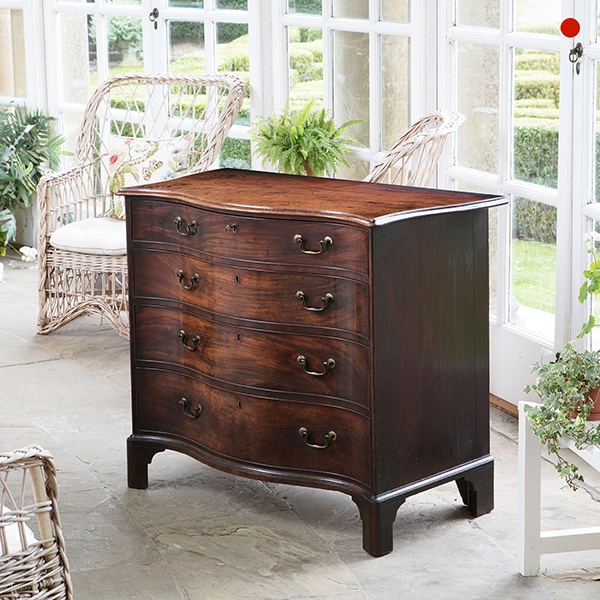
A fine George III mahogany serpentine chest of drawers in the manor of Henry Hill of Marlborough
A fine George III mahogany serpentine chest of drawers in the manner of Henry Hill. With ebonised, ogee moulded serpentine dovetail-housed top.

William and Mary Kingwood or ‘Princes Wood’ Oyster Table Box
William & Mary Kingwood Oyster Table Box or ‘Princes Wood’, Circa 1690. England. Originally designed to store tableware and was given the apt name ‘table box’.
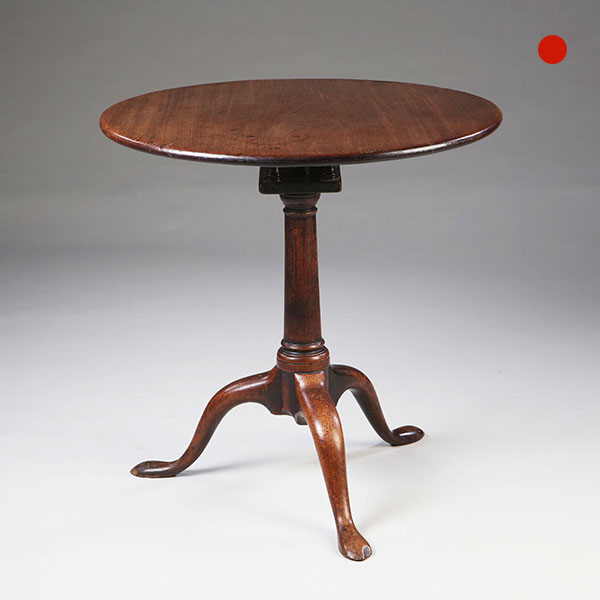
George III Mahogany Tripod or Snap
George III Mahogany Tripod Table or Snap-Top Table with Birdcage circa 1770. England SOLD Follow UsGeorge III Mahogany Tripod or Snap-Top Table with Birdcage, circa 1770. England Of solid mahogany, the gun barrel and one-piece top are raised...
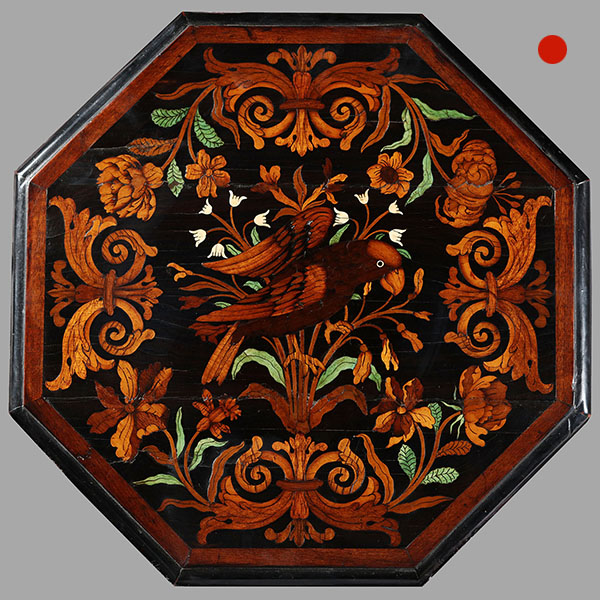
17th-Century Floral Marquetry Candle Stand
17th-Century Floral Marquetry Candle Stand, 1675-1690. The Metropolitan Museum of Art in New York decided to auction a number of pieces of exceptional merit.
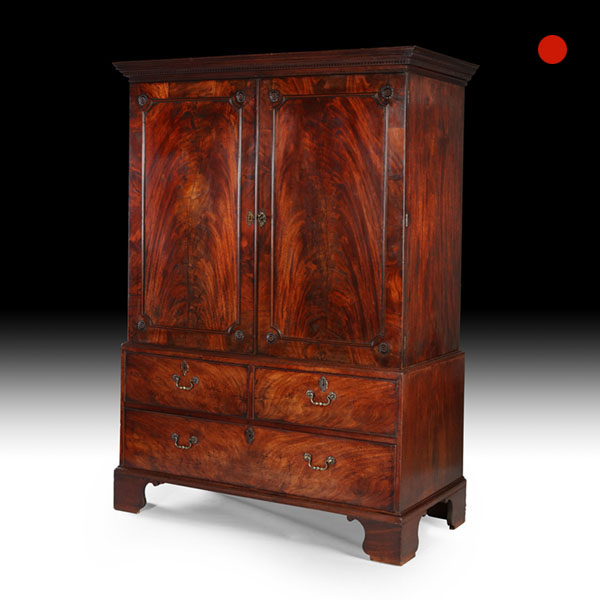
George III Mahogany Linen Press Wardrobe
George III Mahogany Linen Press Wardrobe 1760 England SoldGeorge III Mahogany Linen Press Wardrobe A fine George III mahogany linen press in outstanding original condition. The press was obviously made to exceed with the cabinetmaker using...
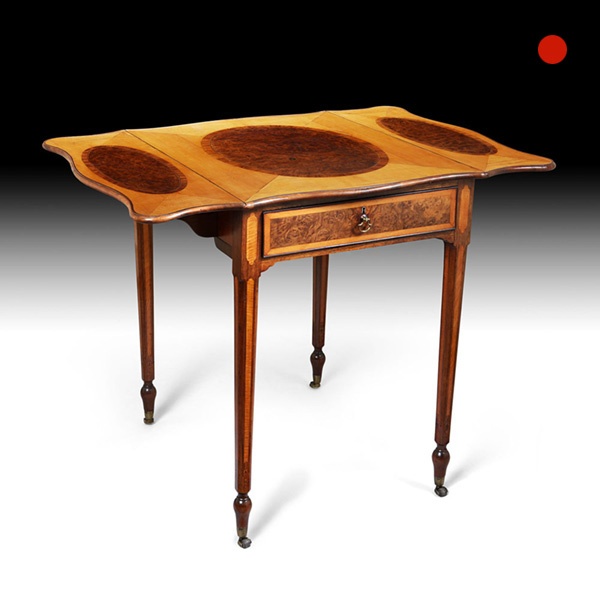
18th Century George III Satinwood and Pollard Oak Pembroke Occasional Table
An exceptionally fine and rare George III satinwood and pollard oak Pembroke table. The padauk top is veneered in satinwood cantered by large ovals of tightly clustered burr pollard oak reserves, bordered in princess wood and lined with fine ebony and box stringing.

A fine George III mahogany serpentine chest of drawers in the manor of Henry Hill of Marlborough
A fine George III mahogany serpentine chest of drawers in the manner of Henry Hill. With ebonised, ogee moulded serpentine dovetail-housed top.

William and Mary Kingwood or ‘Princes Wood’ Oyster Table Box
William & Mary Kingwood Oyster Table Box or ‘Princes Wood’, Circa 1690. England. Originally designed to store tableware and was given the apt name ‘table box’.

George III Mahogany Tripod or Snap
George III Mahogany Tripod Table or Snap-Top Table with Birdcage circa 1770. England SOLD Follow UsGeorge III Mahogany Tripod or Snap-Top Table with Birdcage, circa 1770. England Of solid mahogany, the gun barrel and one-piece top are raised...

17th-Century Floral Marquetry Candle Stand
17th-Century Floral Marquetry Candle Stand, 1675-1690. The Metropolitan Museum of Art in New York decided to auction a number of pieces of exceptional merit.

George III Mahogany Linen Press Wardrobe
George III Mahogany Linen Press Wardrobe 1760 England SoldGeorge III Mahogany Linen Press Wardrobe A fine George III mahogany linen press in outstanding original condition. The press was obviously made to exceed with the cabinetmaker using...

18th Century George III Satinwood and Pollard Oak Pembroke Occasional Table
An exceptionally fine and rare George III satinwood and pollard oak Pembroke table. The padauk top is veneered in satinwood cantered by large ovals of tightly clustered burr pollard oak reserves, bordered in princess wood and lined with fine ebony and box stringing.
YOU MAY ALSO LIKE
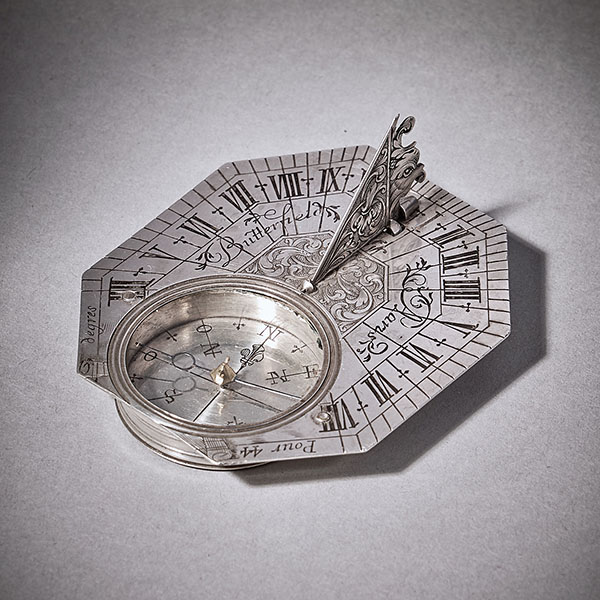
Rare Silver Pocket Sundial and Compass by Michael Butterfield, Paris, circa 1700
Rare Silver Pocket Sundial and Compass by Michael Butterfield, Paris, circa 1700 £4,900 Follow UsRare Silver Pocket Sundial and Compass by Michael Butterfield, Paris, circa 1700 A beautiful, rare solid silver Anglo-French octagonal pocket...

Engraved Eight-Day Striking and Repeating Carriage Clock by Perregaux Au Locle
Engraved Eight-Day Striking and Repeating Carriage Clock by Perregaux Au Locle Follow UsEngraved Eight-Day Striking and Repeating Carriage Clock by Perregaux Au Locle The superb engraved gilt gorge brass case has facetted glass panels to all...

Fine George III 18th Century Period Mahogany Longcase Clock by Tomas Fowle
18th Century Period Mahogany Longcase Clock by Tomas Fowle £12,995 Follow Us18th Century Period Mahogany Longcase Clock by Tomas Fowle A fine George III period mahogany longcase clock of excellent colour, patination and proportions, circa...

17th Century Figured Walnut and Seaweed Marquetry Lace Box
17th Century Figured Walnut and Seaweed Marquetry Lace Box £3,600 Follow Us17th Century Figured Walnut and Seaweed Marquetry Lace Box A fine and extremely rare figured walnut and seaweed marquetry 'lace box', circa.... let’s break it down -...

19th Century Repeating Gilt-Brass Carriage Clock by the Famous Drocourt
19th Century Repeating Gilt-Brass Carriage Clock by the Famous Drocourt £5,600 Follow Us19th Century Repeating Gilt-Brass Carriage Clock by the Famous Drocourt A superb repeating carriage clock with a gilt-brass gorge case by the famous maker...

17th-Century Hague Clock Signed by Pieter Visbagh, circa 1675
Small 17th Century Hague clock made c. 1675 by Pieter Visbagh, who was apprenticed by Salomon Coster. The latter made the first pendulum clock according to the instructions of Christiaan Huygens, the internationally renowned scientist who developed the idea of applying a pendulum to a clock movement.

Rare Silver Pocket Sundial and Compass by Michael Butterfield, Paris, circa 1700
Rare Silver Pocket Sundial and Compass by Michael Butterfield, Paris, circa 1700 £4,900 Follow UsRare Silver Pocket Sundial and Compass by Michael Butterfield, Paris, circa 1700 A beautiful, rare solid silver Anglo-French octagonal pocket...

Engraved Eight-Day Striking and Repeating Carriage Clock by Perregaux Au Locle
Engraved Eight-Day Striking and Repeating Carriage Clock by Perregaux Au Locle Follow UsEngraved Eight-Day Striking and Repeating Carriage Clock by Perregaux Au Locle The superb engraved gilt gorge brass case has facetted glass panels to all...

Fine George III 18th Century Period Mahogany Longcase Clock by Tomas Fowle
18th Century Period Mahogany Longcase Clock by Tomas Fowle £12,995 Follow Us18th Century Period Mahogany Longcase Clock by Tomas Fowle A fine George III period mahogany longcase clock of excellent colour, patination and proportions, circa...

17th Century Figured Walnut and Seaweed Marquetry Lace Box
17th Century Figured Walnut and Seaweed Marquetry Lace Box £3,600 Follow Us17th Century Figured Walnut and Seaweed Marquetry Lace Box A fine and extremely rare figured walnut and seaweed marquetry 'lace box', circa.... let’s break it down -...

19th Century Repeating Gilt-Brass Carriage Clock by the Famous Drocourt
19th Century Repeating Gilt-Brass Carriage Clock by the Famous Drocourt £5,600 Follow Us19th Century Repeating Gilt-Brass Carriage Clock by the Famous Drocourt A superb repeating carriage clock with a gilt-brass gorge case by the famous maker...

17th-Century Hague Clock Signed by Pieter Visbagh, circa 1675
Small 17th Century Hague clock made c. 1675 by Pieter Visbagh, who was apprenticed by Salomon Coster. The latter made the first pendulum clock according to the instructions of Christiaan Huygens, the internationally renowned scientist who developed the idea of applying a pendulum to a clock movement.










